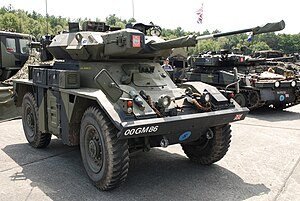- This article is about the post-war British vehicle. For the World War II Canadian vehicle, see Fox Armoured Car. For the German/American NBC reconnaissance vehicle see M93 Fox
FV721 Fox  FV721 Fox in Ursel, Belgium
FV721 Fox in Ursel, BelgiumType Armoured car Place of origin United Kingdom Specifications Mass 6.75 tonnes (7.44 short tons; 6.64 long tons) Length 5.08 m (16 ft 8 in) Width 2.13 m (7 ft 0 in) Height 2.2 m (7 ft 3 in) Crew 3 Armor Aluminium Main
armament30 mm L21 RARDEN cannon Secondary
armamentCo-axial 7.62 mm L37A2 machine gun Engine Jaguar J.60 No 1 Mk 100B Petrol
190 hp (142 kW)Power/weight 28.1 hp/tonne Suspension Wheel Operational
range434 km (269.675 mi) Maximum speed 104 km/h (64.6 mph) The FV721 Fox Combat Vehicle Reconnaissance (Wheeled) (CVR(W)) was a 4x4 armoured car deployed by the British Army as a replacement for the Ferret scout car and the Saladin Armoured Car. The Fox was introduced into service in May 1973 and withdrawn in 1993/4.
Description[]
It had a crew of three and had a low profile rotating turret armed with a 30 mm L21 RARDEN cannon which was manually fed with 3 round clips; 99 rounds were carried. A coaxial L37A2 7.62 mm machine gun was mounted with 2,600 rounds. The weapons were not stabilised. This turret was also equipped with a set of 2 4-barrelled smoke dischargers. The vehicle had a combat weight of 6.75 tonnes and was designed to be air-portable.[1] The Fox had aluminium armour and was fitted with a flotation screen. It lacked protection against nuclear, biological and chemical weapons. Powered by a Jaguar 4.2-litre 6-cylinder petrol engine, the Fox was one of the fastest vehicles of its type.
The Fox was typically attached to armoured and mechanized infantry battalions. The use of high mobility light vehicles such as the Fox would provide the ability to out flank heavier armoured divisions. This also potentially enabled the Fox to act as a scout and a vehicle that can engage similar light vehicles. The Fox's all-welded aluminum armour hull and turret protected against medium gun fire and artillery splinters. But did not protect the Fox from heavy (50.calbre) machine gun fire. The driver viewed through an integral periscope/hatch cover that lifts open while the centred turret holds the commander/loader on the left and gunner on the right.[1]
Without preparation, the Fox can ford one metre of water and a flotation screen can be erected in two minutes.
Air portable, three Foxes can be carried by one C-130 Hercules aircraft,[1] two of which can be parachute dropped.
Variants[]

FV722 Vixen prototype at Bovington Tank Museum
- FV722 Vixen - Un-turreted version, was planned and trialled but never entered production. An example of the Vixen is held at the Bovington museum. Hull #2 is in restored & running condition in Australia.
- Polecat - There was at least one trial version of a Fox chassis mounting the standard UK GPMG one-man turret (as used on the FV432 APC) and possibly one with a larger one man turret mounting an M2 .5in heavy MG. Both types were proposed for use in Ulster during the 1980s as patrol vehicles.
- Panga - Export version for Malaysia, fitted with Helio FVT-800 machine gun turret. Prototype only.
- Fox-Scout - Escort version with 7.62 mm machine gun (MAG or Chain gun) and 4,500 rounds. Prototype only.
- Fox 25 - Fitted with a 25 mm Chain Gun in a Sharpshooter turret. Crew: 2. Prototype only.
- Fox MILAN - Tankhunter version with MILAN Compact Turret. Prototype only.
- Sabre - The turret of the Fox was remounted on the chassis of an FV101 Scorpion hull to create a new tracked reconnaissance vehicle, the Sabre. Cheaper to produce than the similar FV107 Scimitar, one Hundred and Thirty Six Sabres were created. Modifications included; redesigning the smoke grenade dischargers, replacing the standard machine gun with a L94A1 chain gun and domed hatches to improve headroom for the commander and gunner. They were assigned to reconnaissance platoons of armoured and mechanised infantry battalions before being withdrawn from service in 2004.[2]
- FV432/30 - A small number of Fox turrets were added to modified FV 432s in the mid-1970s for the Berlin Brigade, but this project was abandoned after 13 were converted.
Operators[]
References[]
- ↑ 1.0 1.1 1.2 "FV721 Fox Combat Vehicle Reconnaissance (Wheeled)". Inetres.com. 2006-07-20. http://www.inetres.com/gp/military/cv/recon/Fox.html. Retrieved 2010-10-16.
- ↑ "Written Answers to Questions [4 July 2006 Defence Military Vehicles"]. House of Commons Hansard. Parliament of the United Kingdom. http://www.publications.parliament.uk/pa/cm200506/cmhansrd/vo060704/text/60704w0003.htm#06070447001554. Retrieved 2009-01-16.
- ↑ 3.0 3.1 "Janes armor and artillery upgrades, Alvis Vickers 30 mm turret (United Kingdom), AFV TURRETS AND CUPOLAS". Jane's. http://www.janes.com/articles/Janes-Armour-and-Artillery-Upgrades/Alvis-Vickers-30-mm-turret-United-Kingdom.html. Retrieved 17 October 2010.
Sources[]
- Jane's Armour and Artillery 1993–1994, Jane's Information Group, ISBN 0-7106-1074-2
- Taschenbuch der Panzer Edition 7 (1990), Bernard & Graefe Verlag, ISBN 3-7637-5871-2
- Terry Gander, The Modern British Army (1988), Patrick Stephens Limited, ISBN 0-85059-919-9
- Terry Gander, Britain's Modern Army (1995), Patrick Stephens Limited, ISBN 1-85260-428-X
External links[]
Wikimedia Commons has media related to Fox armoured reconnaissance vehicle. - Fox at Inetres.com
- "Fox at Military-vehicle.net". Archived from the original on Sep 28, 2007. http://web.archive.org/web/20070928065214/http://www.military-vehicle.net/vcls/fox.htm.
Post-WWII British AFVsWheeled - Ferret Scout Car
- Fox Reconnaissance Vehicle
- Saladin Armoured Car
- Saracen APC
- Humber Pig
- Saxon
- Mastiff PPV
- Husky TSV
APCs and IFVs Light tanks and
anti-tank vehiclesSP artillery Main battle tanks
Modern armoured fighting vehicles4 × 4 6 × 6 8 × 8 10 × 10 Tracked
All or a portion of this article consists of text from Wikipedia, and is therefore Creative Commons Licensed under GFDL.
The original article can be found at Fox armoured reconnaissance vehicle and the edit history here.
Advertisement
347,158
pages
Fox armoured reconnaissance vehicle
Advertisement